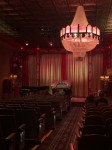Los Angeles’ blend of midnight movies, cult screenings and historic theaters offers late-night scares and childhood nostalgia back in the theater. Join columnist Nina Young as she attends different cult screenings each week to find out why audiences stay out so late after dark.
I should have attended the Old Town Music Hall’s “My Little Chickadee” screening in a corset, bustle and giant feathered hat to embrace the night’s vintage ambiance.
The Friday night event sucked attendees into a time warp of over 70 years, drowning out the modern world with a Mighty Wurlitzer pipe organ before playing the comedy-Western classic for attendees. The 1921 theater – refurbished in 1968 – revives classic flicks for the public, with each screening featuring elements one would’ve found in 1920s cinemas, including musical singalongs and comedy shorts preceding the film.
The oldest film I’ve experienced through my column so far, “My Little Chickadee” stars early Hollywood icons Mae West and W.C. Fields. The Western mostly relies on its comedic leads playing off one another in a saloon or train car, with West spouting double entendres in her alluring drawl and Fields performing slapstick comedy. “My Little Chickadee” does not qualify as a cult film by any means, and insofar as I could tell, audiences don’t attend showings of this 1940s flick intending to chuck popcorn. But I did glimpse at another facet of late night film revivals: the following of classic cinema.
Ben Sampson, a lecturer in the UCLA School of Theater, Film and Television, said that screenings of classic cinema may draw different crowds than that of cult screenings, as the cult phenomenon appeals to an alternative, niche community, whereas classic cinema may appeal to both older crowds and their younger family. Los Angeles theater venues offer revivals for fans knowledgeable about film history, Sampson said, and as a fan of revivals himself, attending screenings in nostalgic theaters adds a romantic quality to modern moviegoing.
“I think it’s a natural fit for people who appreciate old films to want to watch them in their purest form,” Sampson said. “You feel like you’re walking into history. Why do people go to Disneyland? Everyone is interested in being transported.”
The throwback atmosphere of the Old Town Music Hall began before I even turned the corner to face the theater. Lighthearted piano music transformed the music hall’s lime-green facade into a playhouse venue of times past. But stepping over the cinema’s threshold signified how much American theaters have changed; the screening room’s grandiose chandeliers and photos of Hollywood starlets quickly tipped off attendees to the fact that they hadn’t accidentally stumbled into an AMC theater instead.
Visitors at the screening were greeted by ragtime songs played by organist and venue volunteer Edward Torres. Torres said he’s observed fan followings for older films when the music hall previously screened classics such as “Casablanca” and “Sunset Boulevard.” As for “My Little Chickadee,” Torres said he heard from some attendees that the classic was one passed on to them by family.
“It’s the whole idea of passing it on to the next generation, I think, and introducing these type of films to people who would otherwise never be able to see them,” Torres said.
Bathed in the screening room’s soft red lighting, I scanned the space to see a mix of couples, older attendees and even fellow college students in the audience. Attendees Lucas Wilson and Athena Booras said they were encouraged by a college professor to experience the classic film at the music hall. Wilson said finding films such as “My Little Chickadee” proves difficult for younger people interested in classic cinema, thanks to limited library copies or few online resources. Booras said coming to the music hall demonstrated a significant change in modern moviegoing for her.
“It’s very different because when you regularly go to the movies, you have surround sound, and here … you get to step into a different time,” Booras said.
As Torres emerged to play the Wurlitzer and the stage’s curtains disappeared to reveal the rainbow-colored inner workings of the organ, I gathered another screening rule for classic revivals.
Unofficial classic movie screening rule No. 11: Take advantage of the event to uncover tidbits of film history.
Without diminishing its classic status, “My Little Chickadee” was somewhat inaccessible as piece of cinema. While I appreciated West’s innuendos and the wackiness of 1940s Westerns, the film’s slow pacing and awkward editing pulled me out of the screening from time to time. That said, the event’s preshow singalong and comedy short brought a totally different character to the night. Listening to Torres expertly play the pipe organ – which has more than 2,600 pipes and was originally employed alongside silent films – drew the audience into the past through songs such as “Honeysuckle Rose” and even adapted modern ditties like “It’s a Small World.”
I, for one, was unaware that comedy shorts preceded feature films in early Hollywood playhouses; at the Old Time Music Hall, the audience enjoyed a “Popeye the Sailor” cartoon called “King of the Mardi Gras” before “My Little Chickadee.” What’s more, I never expected all the audience members to enthusiastically sing along with the lyrics projected on the venue’s screen, belting out songs such as “Five Foot Two, Eyes of Blue” and “Take Me Out to the Ball Game.”
During the singalong, I heartily joined in the wholesome experience, and upon hearing my own unfortunate singing voice in the darkness, I tried to remember West’s quippy line from the film for comfort: “Honey, I’ve never been embarrassed in my whole life.”
